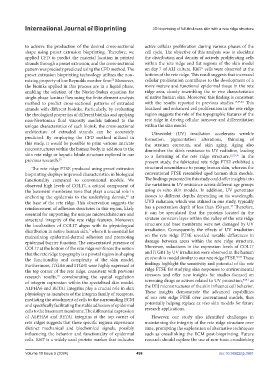Page 506 - IJB-10-5
P. 506
International Journal of Bioprinting 3D bioprinting of full-thickness skin with a rete ridge structure
to achieve the production of the desired cross-sectional active cellular proliferation during various phases of the
shape using preset extrusion bioprinting. Therefore, we cell cycle. The objective of this analysis was to elucidate
applied CFD to predict the material location in printed the distribution and density of actively proliferating cells
strands through a preset extrusion, and the cross-sectional within the rete ridge and flat regions of the skin model
pattern was precisely predicted using the CFD method. The on day 7 of ALI culture. Ki67 cells were observed at the
+
preset extrusion bioprinting technology utilizes the non- bottom of the rete ridge. This result suggests that increased
mixing property of low Reynolds number flow. Moreover, cellular proliferation contributes to the development of a
22
the bioinks applied in this process are in a liquid phase, more mature and functional epidermal tissue in the rete
enabling the solution of the Navier-Stokes equation for ridge area, closely resembling the in vivo characteristics
single-phase laminar flow using the finite element analysis of native human skin. Moreover, this finding is consistent
method to predict cross-sectional patterns of extruded with the results reported in previous studies. 17,33,34 This
strands with different bioinks. Particularly, by evaluating localized and enhanced cell proliferation in the rete ridge
the rheological properties of different bioinks and applying region suggests the role of the topographic features of the
non-Newtonian fluid viscosity models tailored to the rete ridge in driving cellular turnover and differentiation
unique characteristics of each bioink, the cross-sectional within the skin model.
architecture of extruded strands can be accurately Ultraviolet (UV) irradiation accelerates wrinkle
predicted. By employing the CFD method utilized in formation, pigmentation alterations, thinning of
this study, it would be possible to print various intricate the stratum corneum, and skin aging. Aging also
microstructures within the human body, in addition to the diminishes the skin’s resistance to UV radiation, leading
skin rete ridge or hepatic lobule structure explored in our to a flattening of the rete ridge structure. 12,35,36 In the
previous research. 20 present study, the fabricated rete ridge FTSE exhibited a
The rete ridge FTSE produced using preset extrusion structural resemblance to young human skin, whereas the
bioprinting displays improved characteristics in biological conventional FTSE resembled aged human skin models.
functionality compared to conventional models. We The findings presented in this study could offer insights into
observed high levels of COL17, a critical component of the variations in UV resistance across different age groups
the basement membrane zone that plays a crucial role in using in vitro skin models. In addition, UV penetrates
anchoring the epidermis to the underlying dermis, at tissues to different depths depending on its wavelength.
32
the base of the rete ridge. This observation suggests the UVB radiation, which was utilized in our study, typically
37
reinforcement of adhesion structures in this region, likely has a penetration depth of less than 150 μm. Therefore,
essential for supporting the unique microarchitecture and it can be speculated that the proteins located in the
structural integrity of the rete ridge features. Moreover, stratum corneum layer within the valley of the rete ridge
the localization of COL17 aligns with its physiological structure and base membrane were not damaged by UV
distribution in native human skin, where it is essential for irradiation. Consequently, the effects of UV irradiation
5
maintaining epidermal-dermal adhesion and promoting on the rete ridge FTSE revealed notable differences in
epidermal barrier function. The concentrated presence of damage between areas within the rete ridge structure.
COL17 at the bottom of the rete ridge reinforces the notion Moreover, reductions in the expression levels of COL17
that the rete ridge topography is a pivotal region in shaping and ITGB1 by UV irradiation were observed in the human
the functionality and complexity of the skin model. ex vivo skin model similar to our rete ridge FTSE. 38,39 These
Furthermore, ITGA6 and ITGB1 were highly expressed at findings highlight the sensitivity and potential of the rete
the top corner of the rete ridge, consistent with previous ridge FTSE for studying skin responses to environmental
research results, corroborating the spatial regulation stressors and offer new insights for studies focused on
10
40,41
of integrin expression within the specialized skin model. screening drugs or actives related to UV protection, as
ALPHA6 and BETA1 integrins play a crucial role in skin the DEJ microstructures of the skin influence cell behavior.
physiology as members of the integrin family of receptors, These insights demonstrate the advanced capabilities
mediating the attachment of cells to the surrounding ECM of our rete ridge FTSE over conventional models, thus
and specifically facilitating the stable adhesion of epidermal potentially helping replace ex vivo skin models for future
cells to the basement membrane. The differential expression research applications.
of ALPHA6 and BETA1 integrins at the top corner of However, our study also identified challenges in
rete ridges suggests that these specific regions experience maintaining the integrity of the rete ridge structure over
distinct mechanical and biochemical signals, possibly time, prompting the exploration of alternative techniques
influencing the behavior and functionality of epidermal such as crosslinking the ECM post-bioprinting. Future
cells. Ki67 is a widely used protein marker that indicates research should explore the use of non-toxic crosslinking
Volume 10 Issue 5 (2024) 498 doi: 10.36922/ijb.3961

